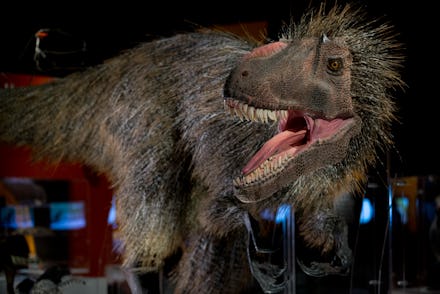Segment of tiny feathered dinosaur's tail found preserved in amber, blows scientific minds

Scientists have discovered a 99-million-year-old fragment of a dinosaur tail suspended in amber — "a once in a lifetime find," as paleontologist Ryan McKellar told CNN, because it provides rare insight into the way dinos actually looked.
As detailed in a report on the specimen published Thursday in the journal Current Biology, these are "the first non-avialan theropod fragments preserved in amber." The segment is believed to have come from a juvenile dinosaur, possibly a coelurosaurian, according to CNN. The tail is covered in brown and white feathers, with bones and tissues and even some blood mummified in its amber tomb.
According to McKellar, who works at Canada's Royal Saskatchewan Museum and helped author the report, the specimen supports the theory that dinosaurs were covered in feathers, rather than scales.
"It is the first time we are seeing skeletal material with feathers coming off of the sides of it and we know for sure that we are dealing with something that is not a bird, it is more dinosaur-like," McKellar said to the Guardian.
"If you were to hold [an adult] in your hand it would have been about the size of a sparrow," he said. The tail is roughly 3.7 centimeters long and, as McKellar said to the Guardian, covered in short, downy feathers that do not point to flight.
Its small size and fringy appearance explain why vendors in the Myanmar market where report co-author Xing Lida spotted the tail fragment originally thought it to be a piece of plant. Lida saw it and thought vertebrate — and indeed, McKellar believes the tiny dino would've had a feathered, mouse-like tail, according to CNN.
Which is all to say, Jurassic Park lied: Dinosaurs probably looked (and sounded) somewhat less fearsome than Hollywood would have us believe.